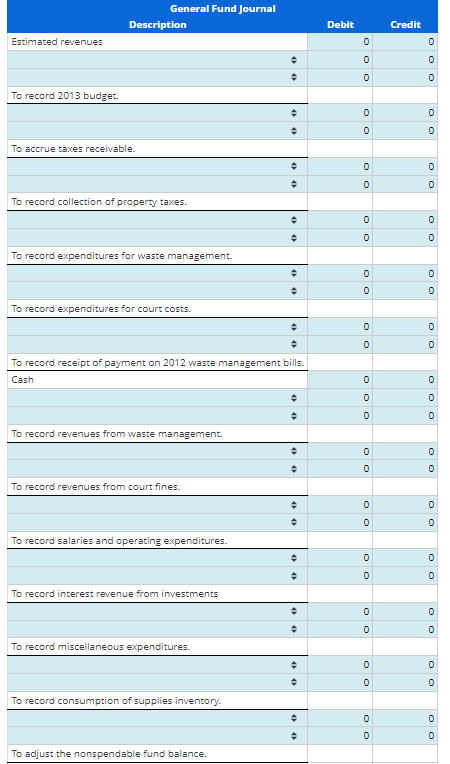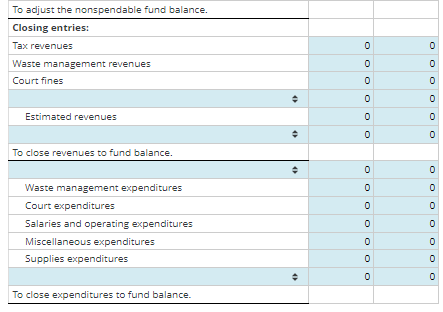Question
Question 36* Incomplete answer Marked out of 76.00 Flag question Question text General Fund Entries and Financial Statements The Town of Amherst, NY finances its
Question 36*
Incomplete answer
Marked out of 76.00
Flag question
Question text
General Fund Entries and Financial Statements
The Town of Amherst, NY finances its operations from revenues collected from property taxes, waste management fees, municipal court fines, and interest on investments. Amherst maintains only a general fund. The following information is available for the year ended December 31, 2013.
1. Following is the general fund trial balance on January 1, 2013:
| Dr (Cr) | |
|---|---|
| Investments | $6,000,000 |
| Cash | 3,500,000 |
| Waste management supplies | 380,000 |
| Accounts receivable-waste management | 400,000 |
| Fund balance-nonspendable | (380,000) |
| Fund balance-unassigned | (9,900,000) |
| Total | $0 |
2. The budget for 2013, adopted by the town board, follows:
| Property taxes | $2,700,000 |
| Waste management costs | 6,700,000 |
| Court costs | 1,150,000 |
| Waste management revenues | 3,500,000 |
| Court fines | 1,000,000 |
| Salaries and operating expenditures | 750,000 |
| Investment income | 250,000 |
| Supplies expenditures | 350,000 |
| Miscellaneous expenditures | 150,000 |
3. All property taxes were collected in cash. Waste management costs, all paid in cash, were $6,680,000. Court costs, all paid in cash, were $1,120,000. 4. Waste management revenues billed during the year: $3,600,000. All outstanding waste management bills on January 1, 2013, were collected during 2013. All 2013 billings were paid with the exception of $210,000 which were mailed to customers the last week of the year. 5. Court fines all collected in cash were $920,000. Salaries and operating expenditures, all paid in cash, were $745,000. Investment income accumulating in the investments account until investments mature: $235,000. No investments matured in 2013. 6. Miscellaneous expenditures, all paid in cash, were $149,000. 7. Waste management supplies on hand at year-end were $40,000. The town uses the consumption method to report supplies.
For all numerical answers, enter all zeros - do not abbreviate to millions or thousands.


Step by Step Solution
There are 3 Steps involved in it
Step: 1

Get Instant Access to Expert-Tailored Solutions
See step-by-step solutions with expert insights and AI powered tools for academic success
Step: 2

Step: 3

Ace Your Homework with AI
Get the answers you need in no time with our AI-driven, step-by-step assistance
Get Started


